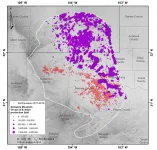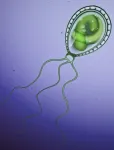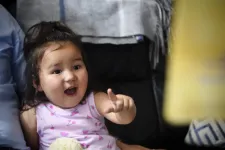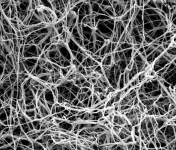GluN3A knockout mouse: Alternative model for Alzheimer's neurodegeneration
Driven by disruption of calcium + neuronal hyperactivity
2021-06-28
(Press-News.org) In the context of recent debate over the FDA's approval of aducanumab, it's refreshing to learn about a model of Alzheimer's neurodegeneration that doesn't start with the pathogenic proteins amyloid or Tau.
A new paper in Alzheimer's & Dementia from Emory neuroscientist Shan Ping Yu and colleagues focuses on an unusual member of the family of NMDA receptors, signaling molecules that are critical for learning and memory. Their findings contain leads for additional research on Alzheimer's, including drugs that are already FDA-approved that could be used preventively, and genes to look at for risk factors.
"It's not just another rodent model of Alzheimer's," Yu says. "We are emphasizing a different set of mechanisms leading to neurodegeneration."
Those mechanisms include alterations in calcium and neuronal hyperactivity, which occur first in this mouse model, rather than standard models that have clumps of amyloid or Tau as the primary drivers.
For the last several years, Yu and his laboratory have been studying the NMDA receptor subunit GluN3A in the context of stroke and also brain development. According to their research, GluN3A acts like a control rod in a nuclear reactor, cooling down signaling in the brain so that things don't overheat. It's an inhibitory part of a receptor assembly that is usually stimulatory.
Yu says GluN3A's role in the adult brain is understudied, because it is generally thought to fade away after early development. Mice that are missing the gene for GluN3A get a benefit earlier in life, in that they have enhanced memory and spatial learning. But later on, the missing gene's function catches up, and the mice develop several features of Alzheimer's, including olfactory deficits, cognitive decline, neurodegeneration and neuroinflammation, and eventually amyloid/tau pathology.
"We show that virtually all clinical symptoms and pathophysiology spontaneously developed in the GluN3A knockout mouse in an age-dependent manner," Yu says.
Yu says he was originally motivated to examine GluN3A's role in neurodegeneration because the GluN3A-knockout mice develop the early symptom of olfactory dysfunction, which is commonly seen in Alzheimer's and Parkinson's patients. In the current paper, Yu and colleagues show that loss of GluN3A leads to elevated calcium levels, normally tightly regulated, and what they call "degenerative excitotoxicity".
This is distinct from the excitotoxicity that is harmful in traumatic brain injury or stroke - milder and more chronic. They connect the hyperactivity and inflammation to the "calcium hypothesis" for Alzheimer's - a well-established idea that dysregulated calcium drives neurodegeneration. Yu says that their discovery of the role of GluN3A relates more to the early stages of the disease, before amyloid plaque formation.
Looking forward, the findings on GluN3A have implications for additional investigation. First, the NMDA receptor inhibitor memantine is FDA-approved for Alzheimer's, but it is generally thought only to have an effect on symptoms. Yu's lab showed that they could prevent some (but not all) deficits by treating GluN3A-mutant mice with memantine. Maybe memantine or a similar drug could play a preventive role if given to people with mild cognitive impairment or early Alzheimer's? Second, genetic variations in GluN3A has barely been studied in Alzheimer's, and studies on other neuropsychiatric conditions suggest that a significant percentage of people carry mutations or deletions affecting GluN3A gene function.
INFORMATION:
Yu and co-senior author Ling Wei are both in Emory's Department of Anesthesiology, with first author research associate Weiwei Zhong, who is now at Thermo Fisher. The research was supported by the National Institute of Neurological Disorders and Stroke (NS057255, NS099596, NS091585), the Veterans Administration (RX001473), the O.Wayne Rollins Endowment fund and John E. Steinhaus Endowment fund.
ELSE PRESS RELEASES FROM THIS DATE:
2021-06-28
Deployable structures -- objects that transition from a compact state to an expanded one -- are used everywhere from backyards to Mars. But as anyone who has ever struggled to open an uncooperative folding chair knows, transforming two-dimensional forms into three-dimensional structures is sometimes a challenge.
Now, researchers from the Harvard John A. Paulson School of Engineering and Applied Sciences (SEAS) and the Harvard Graduate School of Design have developed a deployable system that is light, compact, inexpensive, easy to manufacture, and, most importantly, easy to deploy. By harnessing the mechanical instabilities in curved beams, the system can transform objects into elaborate and customizable 3D configurations on a range of scales, from large-scale furniture to small medical ...
2021-06-28
Boulder, Colo., USA: Subsurface carbon sequestration--storing carbon in
rocks deep underground--offers a partial solution for removing carbon from
the atmosphere. Used alongside emissions reductions, geologic carbon
sequestration could help mitigate anthropogenic climate change. But like
other underground operations, it comes with risks--including earthquakes.
Geophysicists are still working to understand what can trigger
human-induced earthquakes, which have been documented since the 1960s. A
new study, published in Geology on Thursday, explores why part of
a heavily produced oilfield in the U.S. has ...
2021-06-28
Middle ear infections, also known as otitis media, affect more than 80% of the children in the U.S. In a new study, researchers have designed a miniaturized 3D-printed device to inactivate Pseudomonas aeruginosa, a common bacterium that causes the infection.
The device--a microplasma jet array--generates plasma, which is composed of charged particles and reactive molecules that have been previously shown to inactivate various pathogens. "This is the first time anyone has tried treating middle ear infections using plasma technology," said Jungeun Won, a graduate student in the Boppart lab. "Usually, the treatment involves using ...
2021-06-28
HUNTINGTON, W.Va. - According to researchers at Marshall University, a maternal diet rich in Omega-3 fatty acids protects from breast cancer development in offspring. In a new study recently published by Frontiers in Cell and Developmental Biology, researchers noted a significant difference in mice from mothers that were fed a diet rich in canola oil, compared with mothers fed a diet rich in corn oil. A maternal Omega 3-rich diet affected genome-wide epigenetic landscape changes in offspring and potentially modulated gene expression patterns.
Dr. Ata Abbas, a former postdoctoral research fellow in Marshall's Department of Biological Sciences, headed a research team under the leadership ...
2021-06-28
New Brunswick, N.J. (June 28, 2021) - A Rutgers-led study sheds new light on the evolution of photosynthesis in plants and algae, which could help to improve crop production.
The paper appears in the journal New Phytologist.
The scientists reviewed research on the photosynthetic amoeba Paulinella, which is a model to explore a fundamental question about eukaryote evolution: why was there a single origin of algae and plants? That is, why did photosynthesis by primary plastid endosymbiosis not originate multiple times in the tree of life?
Photosynthesis is the process by which plants and other organisms use sunlight to synthesize ...
2021-06-28
A first-of-its-kind longitudinal study of infant curiosity found that months-old babies most captivated by magic tricks became the most curious toddlers, suggesting a pre-verbal baby's level of interest in surprising aspects of the world remains constant over time and could predict their future cognitive ability.
"Something about a baby's curiosity about magic tricks is predicting how curious they become as preschoolers," said Lisa Feigenson, co-director of the Johns Hopkins University Laboratory for Child Development. "What the data suggest is that some three-year-olds have a leg up or seem particularly well positioned to learn a lot about the world."
The findings appear today in Proceedings of the National Academy of Sciences.
Until this study, little was known about curiosity ...
2021-06-28
New Brunswick, N.J. (June 28, 2021) - COVID-19's socio-economic effects will likely cause another severe production crisis in the coffee industry, according to a Rutgers University-led study.
The study, which appears in the journal Proceedings of the National Academy of Sciences, included researchers from the University of Arizona, University of Hawaii at Hilo, CIRAD, Santa Clara University, Purdue University West Lafayette and University of Exeter.
"Any major impacts in the global coffee industry will have serious implications for millions of people across the globe, including the coffee retail ...
2021-06-28
An Australian mammal thought to have been wiped out over 150 years ago can now be crossed off our list of extinct animals, following a new study.
Researchers compared DNA samples fromeight extinct Australian rodents, as well as 42 of their living relatives, to look at the decline of native species since the arrival of Europeans in Australia.
The study showed the extinctGould's mouse was indistinguishable from the Shark Bay mouse, still found on several small islands off the coast of Western Australia.
According to lead author Dr Emily Roycroft ...
2021-06-28
Scientists have made a breakthrough in understanding the process that leads to a blood clot forming in the lungs - a condition that kills more than two thousand people in the UK each year.
The clot forms a pulmonary embolism or blockage, cutting off blood flow to major blood vessels in the lungs.
In many cases, the blockage is caused by fragments that have broken away from a blood clot elsewhere in the body, such as a deep vein thrombosis in one of the legs. The fragments are transported to the lungs via the blood stream.
In a paper published today (28 June) in the scientific ...
2021-06-28
The billions of microbes living in your gut could play a key role in supporting the formation of new nerve cells in the adult brain, with the potential to possibly prevent memory loss in old age and help to repair and renew nerve cells after injury, an international research team spanning Singapore, UK, Australia, Canada, US, and Sweden has discovered.
The international investigating team led by Principal Investigator Professor Sven Pettersson, National Neuroscience Institute of Singapore, and Visiting Professor at Lee Kong Chian School of Medicine, Nanyang Technological University, Singapore (NTU Singapore), and Sunway University, Malaysia, found that gut microbes that metabolise tryptophan - an essential amino acid - secrete small molecules called ...
LAST 30 PRESS RELEASES:
[Press-News.org] GluN3A knockout mouse: Alternative model for Alzheimer's neurodegeneration
Driven by disruption of calcium + neuronal hyperactivity








